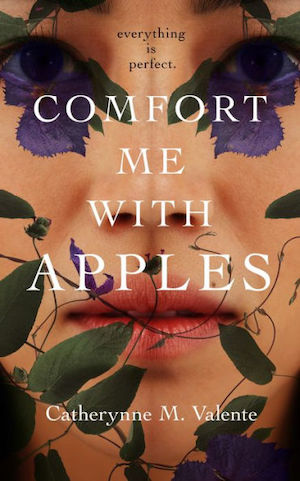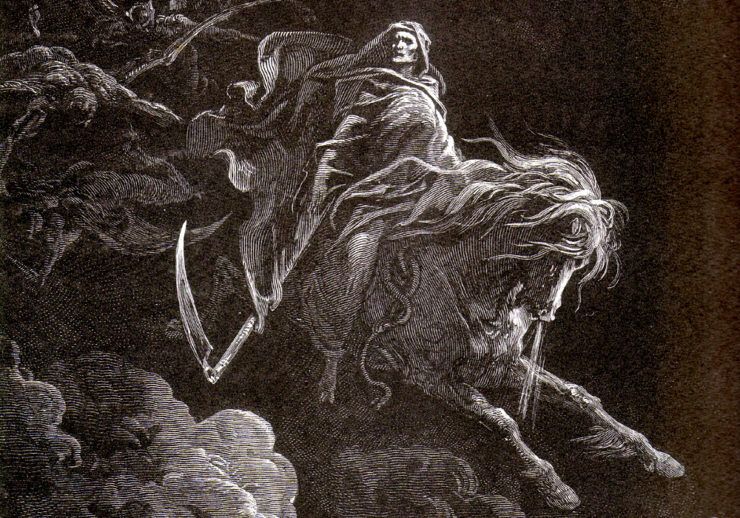I am working on a post about saddles, and it will happen, I promise. But I’m caught up here in the dark of my ancestral year, a little too literally in a few too many ways, to the extent that I am calling this Deathtober, and as for 2021, my word for that is not even printable. Because I live in a fantasy novel, with a herd of fantasy horses, I am aware every day of the Powers that reside in the white horse.
I’ve written about white horse magic before, in an article that gets repeated every so often on the site. I’ve written about horse sacrifices, too, and not just in the academic sense. Actual horse deaths, which have seemed to come in clusters. And all too often in the past couple of years, human deaths in the hundreds of thousands, and animal deaths that just keep on coming. Dogs, cats. Other loved companions.
The human mind makes connections. That’s what it does. As true as it is that correlation does not imply causation, when we’re doing our best to navigate through the forces of chaos and entropy, it’s hard to resist the temptation to believe that something, or someone, is shaping the world to its own ends. And those ends, along about now, do not seem to be in our favor.
The writer’s mind not only makes connections. It constructs those into whole worlds and histories and magical systems. Or non-magical, depending on your genre. Fantasy? Magic. Science fiction? Technology, probably, though it might be indistinguishable from magic. Mystery? Definitely empirical reality, and a mundane explanation for whatever is happening.
I’m in the fantasy zone this week. The veil between worlds is so thin as to be transparent. My little autumn-leaf-colored cat familiar, who died once already and came back in almost the same form but this time with her family, suddenly declined last week and slid through to the other side. Her brother is getting ready to follow. Her sister left last year. In between, the kitten who came to comfort me grew a tumor that swallowed his heart, and left in the spring.
The ancient part of my brain says these are willing sacrifices, and the protections on this piece of sacred land are stronger with each one of them. Cats are of the Fey, they say. They were gods once. They still carry great power on both sides.
We’re by no means unprotected. The sister of the kitten is still with us, and she’s even more fey than he was. Another kitten came in the summer, a golden lion-cat (born on Star Wars Day, as near as we can calculate—for a bit of cross-genre connection), and he’s a strong guardian even at his young age.
But this is the Horseblog, and the horses anchor this place at all points. The white mare born on Star Wars Day (yes, a coincidence!) sacrificed herself to the deadliest snake in North America, which would have bitten me if I’d stepped into her stall a minute or two sooner, and left us in the spring, three years ago. She’s buried standing upright, facing the west, on guard as the White Horse has been for millennia out of count.
The Great Old One, the very large white mare who shook the earth with her foot, passed in a dream in the beginning of autumn, two years ago. She lies under the earth a few feet from where she died. My current Eldest stands beside her in the afternoons. She’s there then, I think; Eldest sees her, and keeps her company.
Buy the Book


Comfort Me With Apples
A year ago almost to the day, the king stallion died. He went in his sleep, on his own, just before I came out in the morning. He had been showing signs of trouble, and I had considered that he might have to be gelded, to save his life. That was his answer. “I would rather die.”
He left just as the gates opened to the Otherworld. His daughter was there to greet him, I think. She was born at Beltane, and died around the summer solstice, just a few months before her father.
Today, as I write this, there’s a new king in the old king’s death-place. It took him a while to get here, between fire and flood and hurricanes disrupting transport, but he started on his way at Midsummer and was to arrive around Lughnasadh, but he had to wait a few more weeks. He’s settled well into his new kingdom. He brings hope and peace. He’s a guardian and a defender, and the mares adore him.
Mares rule the world. If they approve, we know he’s meant to be here.
In my fantasy novel, death is not an easy thing. It’s brutally hard to lose what one loves. But here on the border of Mexico, we understand something that my Celtic ancestors understood, too.
Death is part of life. In the Middle Ages they made a chant of it: “Media vita in morte sumus”—in the midst of life we are in death. In the Celtic world, our world and the Otherworld were paired for eternity; creatures of this world cross into the Other, and at certain times of year, the creatures of that world could enter into ours. Those are the gates the White Horse guards.
In Mexico, where Native and colonialist traditions mesh, Dia de los Muertos, the Day of the Dead, is not a sorrowful time. It’s a festival. One visits the graves of one’s loved ones and one’s ancestors. One brings food and gifts, and keeps the dead company through the night. One tells them what’s been happening through the year, and maybe they’ll have stories to share, too.
Modern American culture has a habit of hiding from death. We don’t talk about it. We don’t want to hear about it. We sanitize it. Even under Covid, especially under Covid, we pretend it doesn’t exist, even to the extent of calling it a hoax. We’re in full-on, full-voiced denial.
Animals make it harder to live that way. There are plenty of people who dump their aged pets in shelters or on the streets or send their horses to the kill auctions. But for every one who does that, I think there’s at least one who stays with them all the way to the end.
Sometimes they go on their own. Sometimes we have to help. Either way, just as we shared our lives with them, we share their death. We try to give them peace. We face the darkness with them. On the other side, we hope, there’s light.
Judith Tarr is a lifelong horse person. She supports her habit by writing works of fantasy and science fiction as well as historical novels, many of which have been published as ebooks. She’s written a primer for writers who want to write about horses: Writing Horses: The Fine Art of Getting It Right. She lives near Tucson, Arizona with a herd of Lipizzans, a clowder of cats, and a blue-eyed dog.










